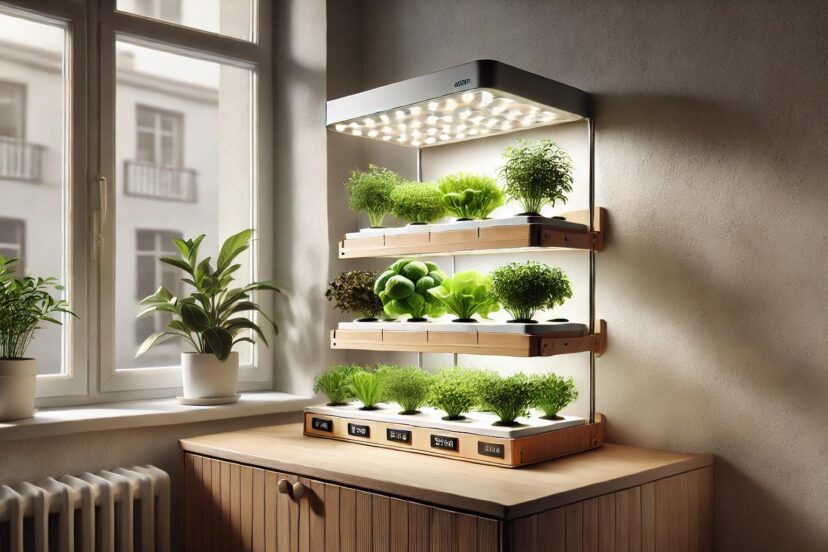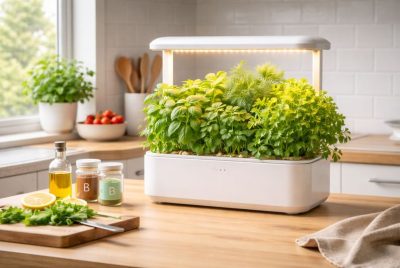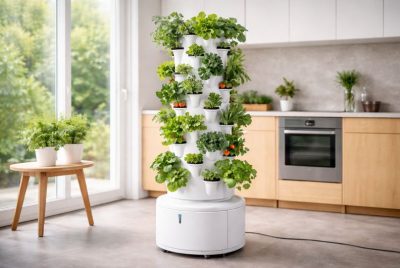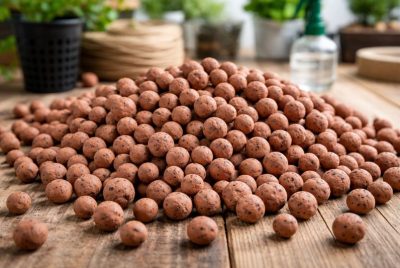Indoor Hydroponic Garden: A Green Revolution Inside Your Home
We may earn a commission for purchases made using our links. Please see our disclosure for more details.
While walking outside, you saw a small garden filled with fresh greens. You thought to yourself, “How lovely! I want that too!” but you don’t have a backyard at home. You have a green thumb or maybe a heart for gardening but the odds won’t let you. Don’t be sad! You can achieve that dream lush garden of yours through an indoor hydroponic garden! Imagine waking up to a view of fresh herbs or vibrant vegetables. I bet you’d love that! So, let’s dig deeper and learn how it works.
What Is an Indoor Hydroponic Garden?
An indoor hydroponic garden, as the name suggests, is a garden inside your house. No, these aren’t just like one to two plant pots you placed on the window. Think of it like a mini garden, just placed inside your home. Make sense? And instead of soil, this garden uses nutrient solution water to nurture plants, making sure they’re healthy. The nutrients they need are delivered directly to their roots (no need to be messy and dig the soil). Thanks to technology advancements, hydroponics can now make your dream indoor garden come true.
Indoor hydroponic gardening offers sustainable solutions for growing food, as highlighted in various studies. A detailed analysis from ScienceDirect shows how hydroponic systems maximize crop yields while reducing resource use, making it a key practice for urban farming (read the full study here). Similarly, research from Harvard University explores the use of water to nourish plants, emphasizing its role in improving food security and reducing environmental impact (learn more about hydroponics here). These studies showcase hydroponics as a promising, eco-friendly alternative to traditional farming.
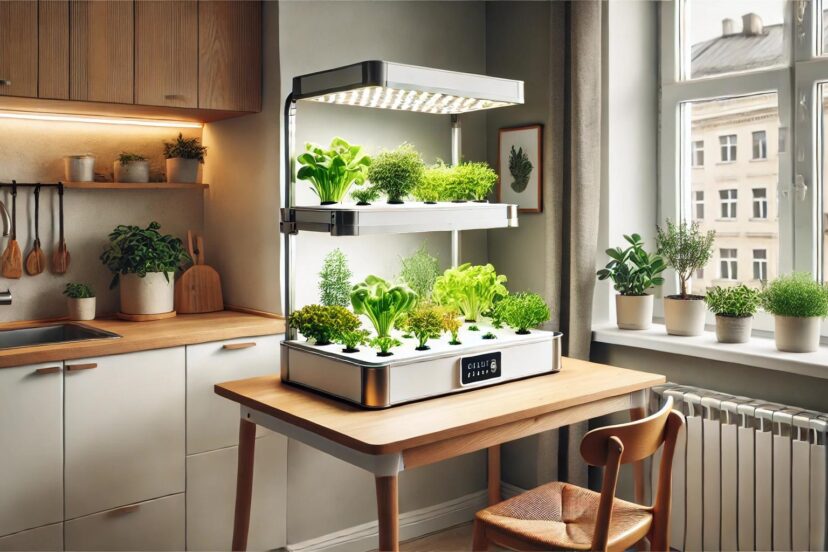
Why Choose Hydroponics Over Traditional Gardening?
If you’re tired of unpredictable weather, soil problems, or uninvited pests (army of troublemakers) that repeatedly kill your precious plants (ugh, so frustrating, I know), then it’s time to switch gardening methods. Here’s a quick story time: I grew up thinking that soil-grown plants are always the best and more ‘organic’. But I was wrong! My friend introduced me to the world of hydroponics and wow, it blew my mind. Changed my perception of gardening too! I realized that there are tons of benefits hydroponics can offer: Faster growth (since they get the nutrients directly to the roots), year-round harvests (plant any time of the year!), and water conservation (it uses less water than traditional gardening). Oh and the best part? It’s a real space saver. Literally, it can fit in any space, even inside your apartment you can practice your green thumb. Traditional gardening is still good but you can bring your plants inside with hydroponics.
How Does an Indoor Hydroponic Garden Work?
Alright, so how does this magnificent technology work? Hey, just to be clear, it’s pure science, not magic. So, in hydroponics, you have a reservoir. This reservoir is the heart of the system. Why? Because this is where the nutrient solution is stored. Next is the grow tray, where your plants rest in net pots with a growing system (like coco coir or pebbles) that serves as an anchor while your plant’s roots dangle into the nutrient-rich water. There’s also a pump that circulates the water, keeping those roots well-fed. Lastly, since we’re indoors we need to have good lighting. LED grow lights are as good as the sunlight and they help plants thrive. Pretty simple, right?
Types of Hydroponic Systems for Indoor Gardening
Ready to set up your own indoor garden? There are different types of hydroponic systems, each with its own personality, so you can choose one that fits your style and space.
1. Deep Water Culture (DWC)
DWC is what I recommend for beginners because it’s simple and effective. The plant’s roots dangle directly into a reservoir of nutrient solution, oxygenated by an air pump.
2. Nutrient Film Technique (NFT)
NFT uses a gentle flow of nutrients over the roots for quick growth which is both efficient and low-maintenance. It’s perfect for smaller plants like herbs (mints or basil).
3. Aeroponics
Think you’re an expert on this? The Aeroponics might be for you. In this system, roots are suspended in the air and misted with a nutrient solution. Yeah, it requires a bit more care but rewards you with rapid growth.
4. Wick System
A low-tech, no-pump system that uses a wick to draw nutrients to the roots. Ideal for smaller plants, it’s a dependable option that’s easy to manage.
5. Ebb and Flow
Just like ocean tides, the grow tray is flooded (periodically) with nutrients and then drained, allowing the plants to get just what they need at intervals. This system is versatile and great for larger plants.
Choosing the Right Plants for Your Indoor Hydroponic Garden
Now that you’ve got the system, what about the plants? The beauty of hydroponics is that you can grow a variety of plants indoors, but some thrive better than others:
– Leafy Greens: Spinach, lettuce, and kale are stars in the hydroponic world—they grow fast and don’t need much space.
– Herbs: Basil, cilantro, parsley, mint—your kitchen could turn into an herb garden in no time.
– Tomatoes: Especially cherry tomatoes, which flourish indoors.
– Strawberries: Imagine picking fresh strawberries year-round—sounds like a dream, right?
Start with easy-to-grow plants, and once you’re comfortable, feel free to expand your garden!
Setting Up Your Indoor Hydroponic Garden
Feeling ready to take the plunge? That’s great!!! Let’s walk through the steps to set up your indoor hydroponic garden. You don’t need to be a gardening pro to make it work!
1. Choose Your Space
First things first, you need to find the perfect spot that’s convenient and can accommodate grow lights if needed. I placed my mini indoor garden in the small cozy corner of our kitchen so I have access to natural light and it’s easy for me to grab things. You can also place it in your living room, it’s fine.
2. Pick a System
Now that you have the perfect spot, the next step is to choose a system. Are you a newbie? I suggest DWV. But if you have the budget and experience, go for NFT. Just make sure you have enough space for that inside your home.
3. Get Your Equipment
It’s time to grab some tools and essentials for your indoor hydroponic garden! You’ll need basics like a grow tray, grow bags, net pots, growing medium, water pump, and grow light. Don’t have time for shopping? Get a hydroponic starter kit, that will be just fine.
4. Mix the Nutrients
Hydroponic plants need a special blend of nutrients, easily available in pre-mixed solutions. I have tried general hydroponics nutrient solutions and all I can say is that they’re high-quality and effective. Try them too!
5. Plant Your Seeds or Seedlings
Get our hands working and place seedlings in the growing medium. I know, it’s a time-consuming task but just be patient, it’s all worth it! Make sure the roots can access the nutrient solution.
6. Monitor & Adjust
After all the hard work, you still need to monitor your growing plants. Do they have enough water level? Are they getting the right pH and nutrients? Do this to ensure your garden stays healthy and productive.
Must-Have Products for a Thriving Indoor Hydroponic Garden
AeroGarden Harvest Indoor Garden
- Perfect for beginners, this all-in-one hydroponic system comes with LED grow lights and pre-seeded pods for herbs like basil, mint, and parsley.
Hydrofarm Root Spa 5-Gallon Hydroponic Bucket System
- A simple and effective Deep Water Culture (DWC) system that’s great for growing larger plants like tomatoes or peppers.
General Hydroponics pH Control Kit
- Essential for maintaining the right pH balance in your hydroponic system, ensuring optimal plant growth.
- This full-spectrum LED grow light is perfect for larger setups and provides the necessary light for plant growth indoors.
- This easy-to-assemble kit is perfect for anyone starting with hydroponics. It includes everything you need to grow plants from seed to harvest.
Check this out:
Lighting for Your Indoor Hydroponic Garden
Plants still need sunlight to thrive. Since your indoor garden won’t get direct sunlight, you’ll need to provide artificial lighting. No worries because LED grow lights are the perfect substitute and they help your plants photosynthesize. Opt for full-spectrum LEDs to ensure your plants get all the light they need.
Maintaining Your Indoor Hydroponic Garden
While hydroponics might sound high-tech, maintaining your system is pretty straightforward. Here are a few tips to keep your garden thriving:
– Check Water Levels: Ensure the nutrient solution stays at optimal levels.
– Monitor pH: Hydroponic plants prefer a pH range between 5.5 and 6.5. Testing kits make this easy to manage.
– Prevent Algae Growth: Algae love stagnant water, so keep your system clean and ensure your reservoir is covered to block out light.
Benefits of an Indoor Hydroponic Garden
Still wondering why hydroponics? Let’s look at the rewards:
1. Fresh Produce Anytime
Imagine picking fresh veggies just steps from your kitchen. It’s not just convenient; it’s deeply satisfying.
2. Chemical-Free
Since your garden is indoors, there’s no need for harmful pesticides or chemicals.
3. Eco-Friendly
Hydroponics uses less water and produces less waste, making it an environmentally conscious choice.
Common Mistakes to Avoid
Even with its simplicity, beginners often slip up. Here are a few pitfalls to watch out for:
– Ignoring pH Levels: A small oversight, but it can dramatically affect plant growth.
– Overfeeding Nutrients: More nutrients aren’t always better. Stick to the recommended levels.
– Insufficient Lighting: Don’t skimp on grow lights—plants need consistent, strong light to thrive indoors.
Summary
Gardening indoors is made possible by hydroponics. Thanks to this new technology, anyone can have a flourishing indoor hydroponic garden. You can now enjoy fresh produce any time of the year with minimal space and budget while reducing your environmental impact. No need to become an expert because anyone can start their hydroponics journey. So, what are you waiting for? Stop looking at your neighbor’s lovely garden and start making your dream garden come true!
FAQs
1. What plants grow best in an indoor hydroponic garden?
Leafy greens, herbs, and strawberries are some of the best choices for indoor hydroponics.
2. How much light do hydroponic plants need?
They need about 12-16 hours of light daily, usually provided by LED grow lights.
3. Can I grow plants hydroponically without electricity?
Most systems need electricity for pumps and lighting, but a passive wick system can function without it.
4. How often should I change the nutrient solution?
It’s recommended to refresh the nutrient solution every two to three weeks.
5. Is hydroponic gardening expensive to start?
While the initial setup may require an investment, the long-term savings make it cost-effective.

